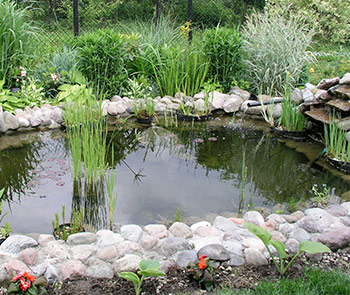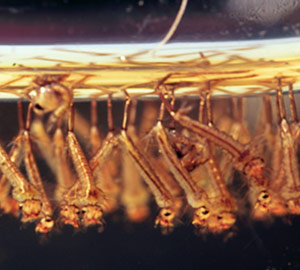5 Ways to Control Mosquitoes in Water Features
Marion Murray, Utah State University Extension IPM Program
 |
|
Shallow water features with standing water can be breeding grounds for mosquitoes. |
The downside to backyard beautiful water features is that some types can be a breeding ground for mosquitoes. Females lay eggs in or next to standing water, and the hatched larvae feed on organic debris, including algae. The larvae are air breathers with a breathing tube like a snorkel (click here for a video of this in action: https://www.youtube.com/watch?v=_9zhLZpgrn4). They periodically must break the water surface to breathe. The larvae spend 5 to 14 days in the water and then pupate into the familiar biting adults.
The Utah Mosquito Abatement program enacts safe larval control measures, but sometimes must spray for adults when there is a high possibility of disease transmission (such as West Nile virus). Help prevent the need for these sprays, and avoid the nuisance of mosquitoes, by managing water features effectively. (And be sure to remove or treat other stagnant water sources.)
Clear the environment
Larvae need organic debris, including algae, not only for feeding, but for protection. Remove excess vegetation and install a pond skimmer, or regularly use a skimmer net to remove debris.
Make the water deep
Mosquito larvae survive best in shallow water. Even one ounce of standing water can support a population of larvae. Water features that are deeper than 2 feet with vertical walls are less likely to be breeding grounds.
Add fish and promote predators
Where feasible, add fish to your water feature. A handful of minnows can consume their weight in mosquito eggs in under a week. Promote beneficial bacteria, nematodes, and insects such as dragonflies and backswimmers that feed on mosquito eggs and larvae by stopping use of broad-spectrum insecticides and synthetic fertilizers.
 |
|
Mosquito larvae breathe through siphoning tubes at the surface of the water. Photo: Jim Occi, BugPics, Bugwood.org |
Disrupt larval activity
Bubblers, fountains, water-wigglers, and waterfalls increase water circulation and prevent mosquito larvae from coming to the surface to breathe.
If the water is not needed for plant growth or for birds or mammals to drink/bathe in, apply small amounts of a vegetable-based oil to coat the surface of the water and reduce surface water tension. The oil will prevent larvae from reaching the surface, and will also prevent newly hatched larvae from getting food below the water.
Use biological control
Some water features that can’t take fish or that have lots of plants or have standing water, may require further intervention with larvicides. The natural bacterium, Bacillus thuringiensis israelensis (Bti), specifically targets larvae of mosquito and related insects (fungus gnat, black fly). It is sold as various brands, including Mosquito Dunks, Mosquito Bits, and Microbe-Lift. The larvae ingest the Bti, and are killed within a few days. Bti affects only fly larvae, so it won’t harm predatory insects living in the pond or water feature, or birds or mammals that ingest the water.
This article originally appeared in Utah Pests News.
